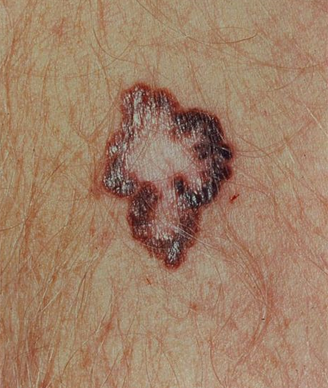Pembrolizumab Improved Survival vs Ipilimumab in Advanced Melanoma
Treatment with pembrolizumab resulted in an estimated 6-month PFS rate that was almost double that of treatment with ipilimumab in advanced melanoma patients.
Metastatic melanoma cells; H&E stain; 320x magnification

Treatment with the anti-programmed cell death 1 (PD-1) antibody pembrolizumab resulted in an estimated 6-month progression-free survival rate that was almost double that of treatment with ipilimumab in patients with advanced melanoma, according to the results of the phase III KEYNOTE-006 trial published in the New England Journal of Medicine and presented at the 2015 American Association for Cancer Research (AACR) Annual Meeting.
“The relative risk of progression or death was decreased by 42% with the two pembrolizumab regimens that were tested, and the relative risk of death was decreased by 31% to 37%,” wrote Caroline Robert, MD, PhD, of Gustave Roussy and Paris-Sud University, and colleagues. “Because the overall survival results at the second interim analysis crossed the prespecified efficacy boundary, the trial was stopped for efficacy and the results were unblinded.”
The KEYNOTE-006 trial included 834 patients with advanced melanoma who were randomly assigned 1:1:1 to pembrolizumab 10 mg/kg every 2 weeks (n = 279) or every 3 weeks (n = 277) or to four doses of ipilimumab 3 mg/kg every 3 weeks (n = 278).
Treatment with pembrolizumab resulted in a significantly improved progression-free survival compared with ipilimumab in the intention-to-treat population. The 6-month progression-free survival rate was 47.3% for pembrolizumab every 2 weeks, 46.4% for pembrolizumab every 3 weeks, and 26.5% for ipilimumab, with median estimated progression-free survival of 5.5 months, 4.1 months, and 2.8 months, respectively.
“The lack of a dose–response relationship is congruent with results of two randomized cohorts in KEYNOTE-001 and the randomized, controlled KEYNOTE-002 trial, in which the administration of pembrolizumab at doses ranging from 2 mg/kg every 3 weeks to 10 mg/kg every 2 weeks did not affect outcomes,” the researchers wrote.
At the time of the second interim analysis, the 1-year estimated overall survival was 74.1% for pembrolizumab every 2 weeks (hazard ratio [HR] for death vs ipilimumab = 0.63; 95% confidence interval [CI], 0.47–0.83; P = .0005), 68.4% for pembrolizumab every 3 weeks (HR for death vs ipilimumab = 0.69; 95% CI, 0.52–0.90; P = .0036), and 58.2% for ipilimumab.
The researchers noted that pembrolizumab had superior survival results in all subgroups except “for the 18% of patients with [programmed death ligand 1] PD-L1–negative tumors, for whom the hazard ratios were 0.91 for those receiving pembrolizumab every 2 weeks and 1.02 for those receiving pembrolizumab every 3 weeks, as compared with ipilimumab.”
Patients assigned to pembrolizumab also had significantly improved response rates compared with those assigned ipilimumab (33.7% for pembrolizumab every 2 weeks [P < .001 vs ipilimumab], 32.9% for pembrolizumab every 3 weeks [P < .001 vs ipilimumab], and 11.9% for ipilimumab).
After a median follow-up of 7.9 months, 89.4% and 96.7% of the pembrolizumab every 2 weeks and every 3 weeks groups, and 87.9% of the ipilimumab group had ongoing responses to treatment.
Finally, the rate of treatment-related adverse events was lower in the two pembrolizumab groups (13.3% and 10.1%) compared with the ipilimumab group (19.9%).